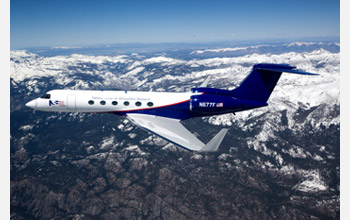Multimedia Gallery
Pacific Dust Experiment (Image 2)
The HIAPER (High-Performance Instrumented Airborne Platform for Environmental Research), a modified Gulfstream-V aircraft owned by the National Science Foundation and operated and maintained by the National Center for Atmospheric Research (NCAR). The plane has a range of about 6,000 miles and can cruise from just a few hundred feet above the Earth's surface to over 50,000 feet.
The G-V was deployed by researchers for PACDEX (Pacific Dust Experiment), a field project launched in April 2007 to study plumes of airborne dust and pollutants that originate in Asia and journey to North America. The plumes are among the largest such events on Earth and are so great in scope, that scientists believe they might affect clouds and weather across thousands of miles, while interacting with the sun's radiation and playing a role in global climate. The plane's features enabled scientists to study the plumes across thousands of miles and at different levels of the atmosphere.
The project was led by scientists from NCAR and the Scripps Institution of Oceanography, with funding provided primarily by the National Science Foundation. To learn more about PACDEX, see NSF Press Release 07-042,
"Scientists Track Impact of Asian Dust and Pollution on Clouds, Climate Change." (Date of Image: 2007) [See related image Here.]
Credit: ©NCAR
Images and other media in the National Science Foundation Multimedia Gallery are available for use in print and electronic material by NSF employees, members of the media, university staff, teachers and the general public. All media in the gallery are intended for personal, educational and nonprofit/non-commercial use only.
Images credited to the National Science Foundation, a federal agency, are in the public domain. The images were created by employees of the United States Government as part of their official duties or prepared by contractors as "works for hire" for NSF. You may freely use NSF-credited images and, at your discretion, credit NSF with a "Courtesy: National Science Foundation" notation.
Additional information about general usage can be found in Conditions.
Also Available:
Download the high-resolution JPG version of the image. (7.2 MB)
Use your mouse to right-click (Mac users may need to Ctrl-click) the link above and choose the option that will save the file or target to your computer.

